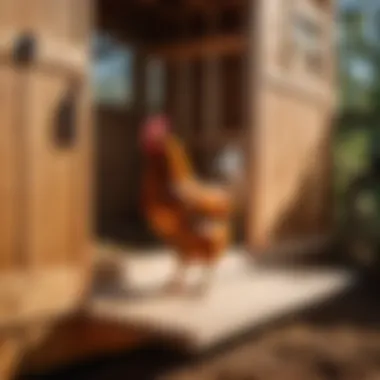Materials:
- 4 sheets of plywood measuring 4ft x 8ft
- 12 pieces of 2x4 lumber each 8ft long
- 1 roll of chicken wire fencing 3ft in height
- Box of galvanized screws and nails
- Hammer
- Screwdriver
- Saw
- Measuring tape
DIY Steps:
- Planning: Begin by sketching a design for your chicken coop, considering size, layout, and features such as nesting boxes and roosting perches.
- Gathering Materials: Purchase or collect the necessary materials listed above, ensuring they are of good quality and appropriate for outdoor use.
- Building: Start by assembling the base using plywood and 2x4 lumber, then frame the walls and attach the roofing material. Install the chicken wire fencing to enclose the coop securely.
- Ensuring Safety: Inspect the coop for any sharp edges or potential hazards. Make sure the coop is predator-proof by reinforcing weak points.
Technical Aspects:
- Tools: Hammer, screwdriver, saw, measuring tape
- Timing: Depending on expertise, the construction can take anywhere from 2 to 4 days to complete.
- Techniques: Use a level to ensure the coop is square and plumb. Pre-drill holes to prevent wood from splitting.
DIY Project Process:


- Installation Method: Begin by building the base frame and flooring, then work upwards to construct the walls and roofing. Install the chicken wire fencing last.
- Key Techniques: Ensure all cuts are precise and fittings are tight to prevent drafts and rain leaks. Use treated lumber for durability.
- Timings: Allow specific drying times for paint or sealant before introducing chickens to their new home.
- Troubleshooting Tips: If the coop appears unstable, reinforce the structure with additional bracing. Check for gaps in the wire to prevent potential predator entry.
Planning Stage


In the process of erecting a homemade chicken coop, the planning stage holds immense significance as it sets the foundation for a sturdy and functional structure. This pivotal phase involves determining the coop size, selecting a suitable location, and sketching the design layout. By meticulously planning each detail, individuals can streamline the construction process and tailor the coop to meet their specific needs and preferences.
Determining Coop Size
When deciding on the size of the chicken coop, it is essential to consider various factors to ensure the comfort and well-being of the feathered inhabitants. Firstly, evaluating the number of chickens that will inhabit the coop is crucial. Calculating the space required per chicken based on recommended guidelines helps prevent overcrowding and promotes a healthy environment. Additionally, factoring in adequate space for roosting and nesting areas is vital. Roosting bars and nesting boxes should be included in the design to accommodate natural chicken behaviors and provide a comfortable living space.
Choosing a Suitable Location
Selecting the right location for the chicken coop is essential for the overall well-being of the birds. Access to sunlight and shade plays a pivotal role in maintaining optimal conditions within the coop. Chickens require exposure to sunlight for vitamin D production while also needing shaded areas to escape excessive heat. Proximity to a water source is another critical consideration. Easy access to water ensures that the chickens remain hydrated and facilitates regular cleaning and maintenance of the coop.
Sketching Design Layout
Drafting a detailed design layout is a fundamental aspect of the planning stage. Accurate measurements are necessary to create a functional and aesthetically pleasing chicken coop. By planning entry and exit points strategically, individuals can ensure convenient access for cleaning and egg collection. Careful consideration of the coop's layout optimizes space utilization and enhances airflow and natural lighting. Through meticulous planning, individuals can create a well-designed chicken coop that meets the specific requirements of their feathered companions.
Materials and Tools


When embarking on the journey of constructing a homemade chicken coop, the choice of materials and tools is crucial. Selecting the right materials and tools sets the foundation for a sturdy and safe coop that will cater to the needs of your feathered friends.
Essential Materials
Lumber for Frame
Lumber for the frame is a fundamental component of any chicken coop. The type of lumber chosen will determine the durability and stability of the structure. Opting for high-quality, treated lumber is essential to ensure longevity and protection against the elements. Pressure-treated pine or cedar are popular choices due to their resistance to rot and insects. These types of lumber provide the necessary strength to support the coop's structure, ensuring it can withstand different weather conditions and the wear and tear of everyday use. Despite the initial cost, investing in quality lumber proves cost-effective in the long run, as it reduces the need for frequent repairs and replacements. Additionally, the dimensional stability of treated lumber helps maintain the structural integrity of the coop over time.
Chicken Wire for Enclosure
Chicken wire plays a vital role in ensuring the safety and security of your flock. The enclosure created by the chicken wire protects the birds from predators while allowing them to roam freely within a defined area. The flexibility and lightweight nature of chicken wire make it an ideal material for creating barriers without obstructing airflow or natural light. Choosing a sturdy gauge of chicken wire is paramount to prevent entry by predators such as raccoons or foxes. The durability of the wire ensures long-lasting protection for the chickens, giving peace of mind to the owner. Additionally, the transparency of chicken wire allows for easy monitoring of the flock without disrupting their natural behavior. While chicken wire is effective, regular maintenance and timely repairs are necessary to address any damage or wear to maintain its protective function.
Required Tools
Hammer and Nails
The hammer and nails are indispensable tools in constructing the chicken coop. The hammer provides the necessary force to secure components together, while nails offer a reliable fastening method. A claw hammer with a comfortable grip and suitable weight is recommended for ease of use and efficiency. Selecting nails of the appropriate length and gauge ensures they penetrate the lumber effectively, forming strong connections that enhance the overall stability of the coop. The precision and control offered by a hammer and nails allow for precise construction, resulting in a structurally sound and secure coop. However, practicing caution and using appropriate safety gear when handling these tools are imperative to prevent accidents or injuries during the building process.
Saw for Cutting Wood
A saw for cutting wood is essential for shaping lumber to the required dimensions in the construction of the coop. Choosing the right type of saw, such as a circular saw or handsaw, depends on the complexity of the cuts needed. A sharp and well-maintained saw ensures clean and accurate cuts, facilitating the assembly process and ensuring a snug fit between components. When using a saw, safety measures such as wearing protective gear and maintaining a stable cutting surface enhance efficiency and reduce the risk of accidents. Additionally, mastering different cutting techniques enables precise execution of design elements, contributing to the overall aesthetic and functionality of the coop.
Construction Process
In the construction process of building a homemade chicken coop, attention to detail is essential to ensure a safe and functional shelter for your feathered companions. This section highlights the step-by-step procedures involved in creating a sturdy chicken coop that meets both the chickens' needs and the owner's requirements. From laying the foundation to final touches, each stage plays a vital role in the overall structure's durability and longevity. By following the construction process meticulously, you can guarantee a secure and comfortable living space for your chickens.
Building the Frame
When constructing a chicken coop, building the frame forms the backbone of the entire structure. The frame provides stability and support, ensuring the coop can withstand various weather conditions and external forces. Assembling the main structure involves precise measurements and strategic placement of materials to create a solid foundation for the coop. The key characteristic of this step is to use high-quality lumber to construct a durable frame that can accommodate the chicken wire and roofing securely. This choice is beneficial as it contributes to the overall structural integrity of the coop, offering long-term resilience against wear and tear. However, a disadvantage could be the initial investment required for quality lumber, but the advantages far outweigh the cost, ensuring a sturdy and reliable final product.
Adding support beams further enhances the frame's strength and durability. These beams provide extra reinforcement to bear the weight of the roof and protect the structure from sagging or collapsing over time. Incorporating support beams is a popular choice in chicken coop construction as it prevents structural weaknesses and prolongs the coop's lifespan. The unique feature of support beams lies in their ability to distribute weight evenly across the frame, safeguarding against potential damage and ensuring the overall stability of the coop. While adding support beams may require additional materials and labor, the advantages include increased structural robustness and a more resilient coop built to last.
Installing Chicken Wire
The installation of chicken wire is a critical step in securing the coop and creating a safe environment for your chickens. The chicken wire serves as a protective barrier that prevents predators from accessing the coop and offers ventilation to ensure proper airflow for the chickens. Securing the wire to the frame is crucial to fortify the coop's perimeter and eliminate potential entry points for predators. The key characteristic of this process is using high-quality, tightly woven chicken wire that is resistant to tampering and breakage. This choice is beneficial as it provides a durable and secure enclosure for the chickens, minimizing the risk of predator attacks. However, a disadvantage could be the time and effort required to securely attach the wire to the frame, but the advantages in terms of safety and protection are unmatched.
Creating door access within the chicken wire facilitates easy entry and exit for both chickens and caretakers. The access door allows for convenient cleaning, feeding, and monitoring of the chickens while maintaining a secure barrier against predators. The key characteristic of door access design is to ensure it is sturdy, easy to operate, and predator-proof. This choice is beneficial as it promotes efficient coop management and enhances the overall functionality of the structure. The unique feature of the door access lies in its versatility, providing a secure gateway that can be opened and closed as needed. While creating door access requires careful planning and installation, the advantages include improved accessibility and security for both chickens and caretakers.
Roofing Installation
Roofing installation is a crucial component of the chicken coop construction process, as it provides protection against harsh weather conditions and ensures the chickens' safety and comfort. Attaching roof plywood forms a weatherproof barrier that shields the coop from rain, snow, and sunlight, maintaining a conducive environment for the chickens. The key characteristic of roof plywood is its durability and ability to withstand extreme weather, offering long-lasting protection for the coop. This choice is beneficial as it enhances the coop's resilience and prolongs its lifespan, providing a secure shelter for the chickens. However, a potential disadvantage could be the weight of the plywood, which may require additional structural support, but the advantages in terms of durability and protection justify the investment.
Applying weatherproofing sealant to the roof plywood further enhances its durability and weather resistance. The sealant acts as a protective barrier that prevents water damage, rot, and mold growth, extending the lifespan of the coop's roof. The key characteristic of weatherproofing sealant is its ability to create a seamless and waterproof coating that seals gaps and prevents leaks. This choice is beneficial as it maintains the integrity of the roof plywood, ensuring long-term protection against elemental damage. The unique feature of weatherproofing sealant lies in its versatility and ease of application, providing a reliable solution for weatherproofing the coop. While applying sealant may require additional time and effort during the construction process, the advantages include superior weather protection and increased durability of the coop's roof.
Finishing Touches
In the final stages of constructing your homemade chicken coop, paying attention to the finishing touches is crucial to ensure the overall functionality and comfort of the coop. Adding finishing touches not only enhances the aesthetics but also plays a significant role in providing a safe and cozy environment for your feathered friends. Elements such as nesting boxes, perimeter security, and ventilation are key components that contribute to the overall well-being of your chickens.
Adding Nesting Boxes
Designing and Installing Boxes
When it comes to designing and installing nesting boxes in your chicken coop, you must consider the needs and habits of your hens. The key characteristic of well-designed nesting boxes is providing a secluded and comfortable space for the hens to lay their eggs. Optimal box size, adequate padding, and ease of access are crucial features to ensure that your hens feel secure and relaxed while laying their eggs. Focusing on this aspect enhances egg production and prevents stress among the hens, making it a popular choice for homemade chicken coops.
Ensuring Comfort for Hens
Ensuring comfort for hens goes beyond just providing nesting boxes. It involves creating a conducive environment that promotes natural behavior and reduces stress. Incorporating features like proper insulation, sufficient ventilation, and ample space for movement significantly contribute to the well-being of the chickens. Additionally, ensuring cleanliness and hygiene in the coop helps prevent diseases and maintains optimal health for the hens. While there may be disadvantages such as higher construction costs or maintenance requirements, the advantages of a comfortable and secure space for your chickens far outweigh the drawbacks.
Securing Perimeter
Digging Trench for Predator Barrier
Digging a trench around the perimeter of your chicken coop serves as a vital barrier against potential predators. The key characteristic of this predator barrier is its effectiveness in deterring burrowing animals from gaining access to the coop. By creating a physical obstacle underground, you prevent predators from digging their way into the coop, thus ensuring the safety of your chickens. While it may require additional effort during the construction phase, the long-term benefits in terms of protection make it a popular choice for securing homemade chicken coops.
Installing Poultry Netting
Installing poultry netting further reinforces the security of your chicken coop. The key characteristic of poultry netting is its ability to prevent aerial predators from invading the coop and safeguarding the chickens from potential threats. By creating a physical barrier around the coop, you add an extra layer of protection, minimizing the risk of attacks. While there may be disadvantages such as initial installation costs or maintenance, the advantages of enhanced security and peace of mind make it a valuable addition to your homemade chicken coop.
Ventilation and Light
Incorporating Windows for Airflow
Proper ventilation is essential for maintaining a healthy environment inside the chicken coop. Incorporating windows for airflow enables fresh air to circulate, reducing moisture buildup and preventing respiratory issues among the chickens. The key characteristic of well-placed windows is to create cross ventilation that ensures adequate airflow without causing drafts. The unique feature of adjustable windows allows you to regulate the airflow based on the weather conditions, providing optimal ventilation year-round. While there may be disadvantages such as potential heat loss during colder months, the advantages of improved air quality and health for the chickens make it a practical choice for your homemade coop.
Implementing Artificial Lighting
Implementing artificial lighting can be beneficial, especially during the shorter days of winter when natural light is limited. The key characteristic of artificial lighting is its ability to simulate natural daylight, encouraging egg production and maintaining consistent laying patterns. By strategically placing lighting fixtures inside the coop, you can ensure that the chickens receive adequate light exposure, promoting their well-being. The unique feature of programmable timers allows you to control the lighting duration, creating a simulated natural cycle for the chickens. While there may be disadvantages such as increased energy consumption, the advantages of year-round egg production and overall health benefits for the chickens justify the use of artificial lighting in your homemade coop.





